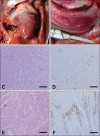Experimental infection of chickens, ducks and quails with the highly pathogenic H5N1 avian influenza virus
- PMID: 19255524
- PMCID: PMC2801098
- DOI: 10.4142/jvs.2009.10.1.53
Experimental infection of chickens, ducks and quails with the highly pathogenic H5N1 avian influenza virus
Abstract
Highly pathogenic avian influenza viruses (HPAIV) of the H5N1 subtype have spread since 2003 in poultry and wild birds in Asia, Europe and Africa. In Korea, the highly pathogenic H5N1 avian influenza outbreaks took place in 2003/2004, 2006/2007 and 2008. As the 2006/2007 isolates differ phylogenetically from the 2003/2004 isolates, we assessed the clinical responses of chickens, ducks and quails to intranasal inoculation of the 2006/2007 index case virus, A/chicken/Korea/IS/06. All the chickens and quails died on 3 days and 3-6 days post-inoculation (DPI), respectively, whilst the ducks only showed signs of mild depression. The uninoculated chickens and quails placed soon after with the inoculated flock died on 5.3 and 7.5 DPI, respectively. Both oropharyngeal and cloacal swabs were taken for all three species during various time intervals after inoculation. It was found that oropharyngeal swabs showed higher viral titers than in cloacal swabs applicable to all three avian species. The chickens and quails shed the virus until they died (up to 3 to 6 days after inoculation, respectively) whilst the ducks shed the virus on 2-4 DPI. The postmortem tissues collected from the chickens and quails on day 3 and days 4-5 and from clinically normal ducks that were euthanized on day 4 contained the virus. However, the ducks had significantly lower viral titers than the chickens or quails. Thus, the three avian species varied significantly in their clinical signs, mortality, tissue virus titers, and duration of virus shedding. Our observations suggest that duck and quail farms should be monitored particularly closely for the presence of HPAIV so that further virus transmission to other avian or mammalian hosts can be prevented.
Figures


Similar articles
-
Pathogenicity of highly pathogenic avian influenza viruses of H5N1 subtype isolated in Thailand for different poultry species.Vet Microbiol. 2009 Jan 1;133(1-2):65-74. doi: 10.1016/j.vetmic.2008.06.020. Epub 2008 Jul 5. Vet Microbiol. 2009. PMID: 18675524
-
Characterization of highly pathogenic H5N1 avian influenza A viruses isolated from South Korea.J Virol. 2005 Mar;79(6):3692-702. doi: 10.1128/JVI.79.6.3692-3702.2005. J Virol. 2005. PMID: 15731263 Free PMC article.
-
Pathogenicity in quails and mice of H5N1 highly pathogenic avian influenza viruses isolated from ducks.Vet Microbiol. 2011 Sep 28;152(3-4):258-65. doi: 10.1016/j.vetmic.2011.05.009. Epub 2011 May 13. Vet Microbiol. 2011. PMID: 21665388
-
Ducks: the "Trojan horses" of H5N1 influenza.Influenza Other Respir Viruses. 2009 Jul;3(4):121-8. doi: 10.1111/j.1750-2659.2009.00084.x. Influenza Other Respir Viruses. 2009. PMID: 19627369 Free PMC article. Review.
-
A review of estimated transmission parameters for the spread of avian influenza viruses.Transbound Emerg Dis. 2022 Nov;69(6):3238-3246. doi: 10.1111/tbed.14675. Epub 2022 Aug 19. Transbound Emerg Dis. 2022. PMID: 35959696 Free PMC article. Review.
Cited by
-
Pathobiology and innate immune responses of gallinaceous poultry to clade 2.3.4.4A H5Nx highly pathogenic avian influenza virus infection.Vet Res. 2019 Nov 1;50(1):89. doi: 10.1186/s13567-019-0704-5. Vet Res. 2019. PMID: 31675983 Free PMC article.
-
Pathogenicity of H5N8 High Pathogenicity Avian Influenza Virus in Chickens and Ducks from South Korea in 2020-2021.Viruses. 2021 Sep 23;13(10):1903. doi: 10.3390/v13101903. Viruses. 2021. PMID: 34696333 Free PMC article.
-
Chicken and duck myotubes are highly susceptible and permissive to influenza virus infection.J Virol. 2015 Mar;89(5):2494-506. doi: 10.1128/JVI.03421-14. Epub 2014 Dec 24. J Virol. 2015. PMID: 25540384 Free PMC article.
-
The complete genome sequence of quail coronavirus identified in disease surveillance on quail farms in South Korea.Poult Sci. 2025 May;104(5):105007. doi: 10.1016/j.psj.2025.105007. Epub 2025 Mar 10. Poult Sci. 2025. PMID: 40088533 Free PMC article.
-
Clade 2.3.4.4b highly pathogenic avian influenza H5N1 viruses: knowns, unknowns, and challenges.J Virol. 2025 Jun 17;99(6):e0042425. doi: 10.1128/jvi.00424-25. Epub 2025 May 9. J Virol. 2025. PMID: 40340397 Free PMC article. Review.
References
-
- Antarasena C, Sirimujalin R, Prommuang P, Blacksell SD, Promkuntod N. Tissue tropism of a Thailand strain of high-pathogenicity avian influenza virus (H5N1) in tissues of naturally infected native chickens (Gallus gallus), Japanese quail (Coturnix coturnix japonica) and ducks (Anas spp.) Avian Pathol. 2006;35:250–253. - PubMed
Publication types
MeSH terms
Substances
LinkOut - more resources
Full Text Sources
Medical
Research Materials

